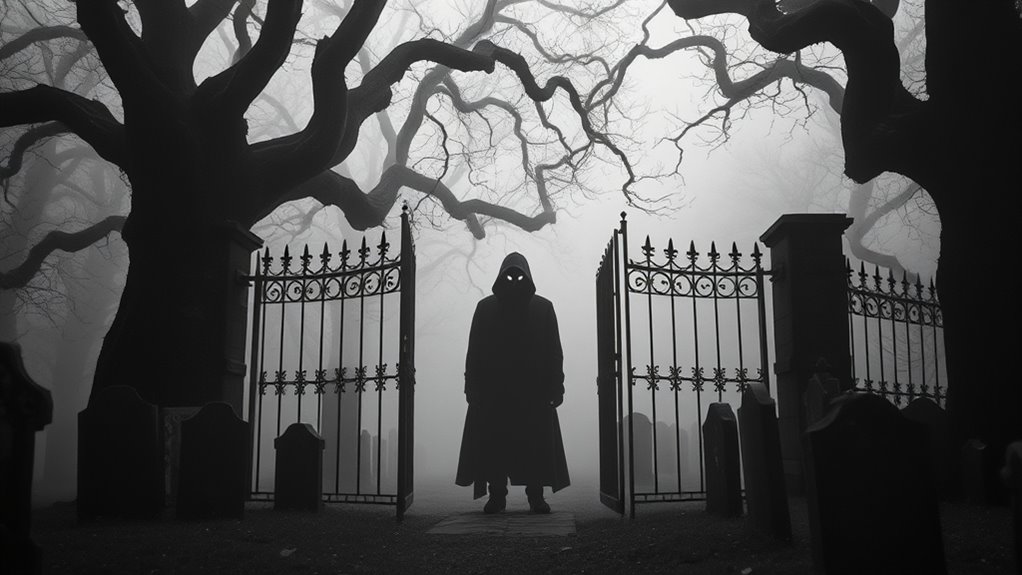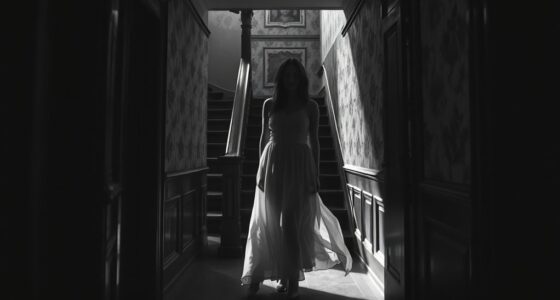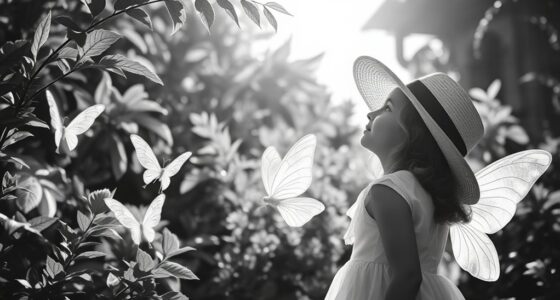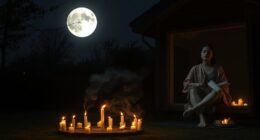In 1970, a panic swept through London surrounding the Highgate Cemetery, where residents reported sightings of a tall, dark figure connected to supernatural tales of a vampire. Media fueled fears, and stories of eerie encounters, animal mutilations, and bizarre rituals spread rapidly, turning the cemetery into a symbol of terror. The event blended superstition and hysteria, reflecting societal fears of the supernatural. If you want to understand how these legends evolved, explore the surprising roots behind this urban legend.
Key Takeaways
- The Highgate Vampire Panic began in 1970, involving reports of a tall, dark figure near Highgate Cemetery in London.
- It was fueled by Victorian Gothic superstitions, media coverage, and local fears, leading to widespread hysteria.
- Sightings included shadowy figures, animal mutilations, and disappearances, which were often sensationalized.
- Some residents believed in a supernatural vampire, performing rituals like staking and exorcisms to ward it off.
- The event exemplifies how urban legends emerge from cultural fears and media influence, transforming the cemetery into a supernatural symbol.

Have you ever heard of the Highgate Vampire Panic? If not, you’re about to discover one of the most enthralling episodes of modern urban legends intertwined with superstitious beliefs. Back in 1970, the quiet area of Highgate in London became the epicenter of a widespread sensation, fueled by rumors, fear, and an increasing fascination with the supernatural. It all began when local residents started reporting strange sightings and eerie encounters near Highgate Cemetery, known for its Victorian tombs and gothic atmosphere. These stories quickly morphed into a city-wide obsession, with many believing they were witnessing the return of a real vampire.
In 1970, Highgate became famous for vampire sightings and supernatural fears.
The panic was driven largely by superstitious beliefs, which had deep roots in Victorian Gothic traditions and folklore. People’s fears were stoked by reports of a tall, dark figure seen lurking at night, alongside claims of animal mutilations and inexplicable disappearances in the area. Over time, these stories took on a life of their own, becoming part of the urban legends that often surround old cemeteries and haunted locales. The idea of a vampire—an undead creature that feeds on the living—fit perfectly into the cultural fears of the time, especially amid the social upheaval and curiosity of the 1960s and 70s. This superstitious mindset contributed significantly to the rapid spread of the panic.
What made the Highgate Vampire Panic different was how quickly it spread through word of mouth, newspapers, and even local radio stations. People began to avoid the cemetery at night, and some even claimed to have seen a tall, shadowy figure with piercing eyes. The media jumped on the story, amplifying the myth and creating a sense of dread that seemed almost contagious. Some residents believed that the vampire was a supernatural entity, while others saw it as a prank or mass hysteria fueled by collective superstitions. The phenomenon was further amplified by media influence, which played a crucial role in spreading the panic and shaping public perception. In addition, urban legends often serve as a reflection of societal anxieties, which may have contributed to the fervor. The cultural context of the era, marked by social change and a fascination with the supernatural, also helped to fuel the story’s popularity.
The story was further bolstered by stories of supposed vampire hunters, who attempted to stake the creature or perform rituals to banish it. These efforts were often accompanied by superstitious rituals, further reinforcing the belief in the creature’s supernatural nature. All of this added layers of intrigue and reinforced the superstitious beliefs that vampires could be real and dangerous. Today, the Highgate Vampire Panic remains an enthralling example of how urban legends can spring from superstitious fears and cultural storytelling, transforming an ordinary cemetery into a symbol of supernatural terror. Whether you believe in vampires or not, the events of 1970 show how powerful collective fears and superstitions can be in shaping local history and myth.
Frequently Asked Questions
Were Any Real Injuries Reported During the Panic?
During the panic, no supernatural injuries or reported attacks were officially documented. You might hear stories of people claiming to have been harmed or attacked, but these aren’t backed by credible evidence. Most reports focus on sightings and strange occurrences rather than actual injuries. So, while the fear was intense, there’s no verified record of anyone suffering supernatural injuries or being attacked during the events.
Did Police Investigate Any Credible Vampire Sightings?
Imagine shadows stretching like monstrous claws as you wonder if the police really chased these vampire sightings. They didn’t buy into the vampire folklore, showing clear skepticism. Despite the eerie reports, the police investigation was brief, dismissing the sightings as hoaxes or mass hysteria. You see, they didn’t take the tales seriously, treating them more like folklore than real threats, which fueled the town’s terrifying yet amusing vampire obsession.
How Did the Media Influence Public Perception of the Panic?
You see that media sensationalism played a big role in shaping public perception during the panic. As reports exaggerated sightings and rumors, you notice public hysteria growing, with more people believing in vampires. The media’s dramatic headlines and stories fueled fears, making the situation worse. This widespread coverage created an environment where panic spread quickly, causing many to believe in the supernatural, even without solid evidence.
Were There Any Eyewitness Accounts From Local Residents?
You’ll find that local resident testimonies during the panic include vivid eyewitness descriptions of strange figures and eerie encounters around the area. Many residents reported seeing shadowy shapes or feeling an unsettling presence, which fueled the growing fear. These eyewitness accounts, often detailed and emotional, played a significant role in shaping the community’s perception of supernatural activity, making the phenomenon seem more real and immediate to everyone involved.
What Impact Did the Event Have on Highgate’S Community?
You see, the event shook the community, sparking fear but also uniting residents in shared concern. While media sensationalism amplified the scare, it strengthened community cohesion as neighbors banded together, facing the strange rumors. The incident left a lasting impression, prompting locals to question their surroundings and trust. Despite the hysteria, it ultimately fostered a sense of solidarity, demonstrating how collective reactions can transform fear into unity.
Conclusion
As you look back, it’s funny how a strange shadow or a whispered rumor can ignite a full-blown panic, almost like fate’s little joke. Just when you think it’s all just stories, a coincidence or two makes you wonder if there’s more to the legend. The Highgate Vampire Panic shows how easily our minds can turn a simple coincidence into a chilling legend, reminding you that sometimes, the line between fact and fiction is thinner than you’d think.









